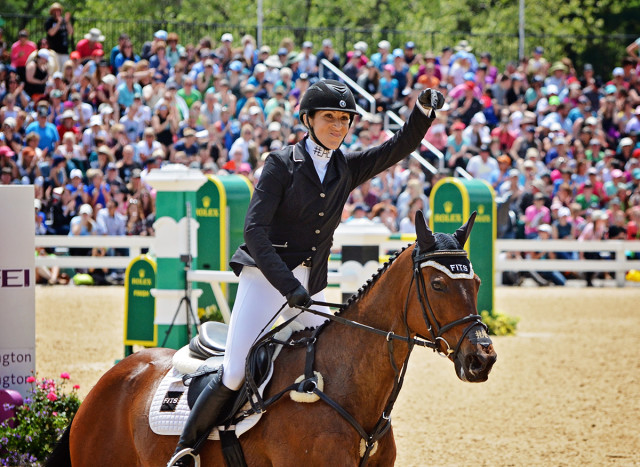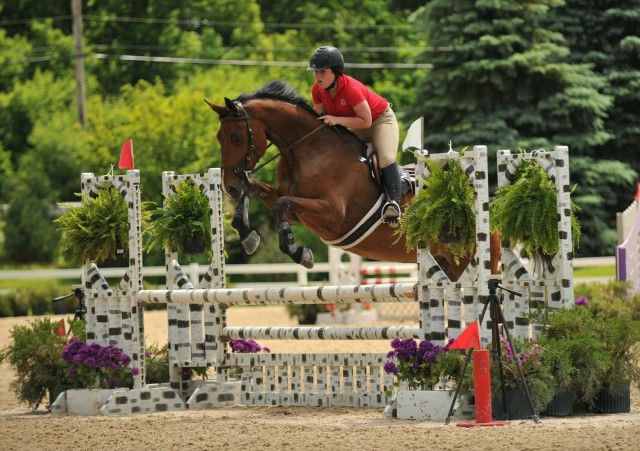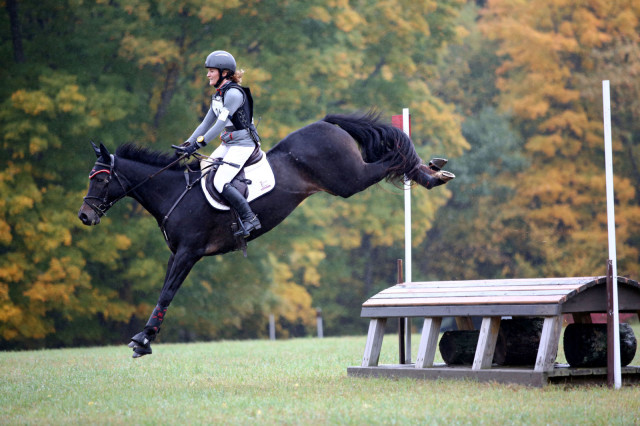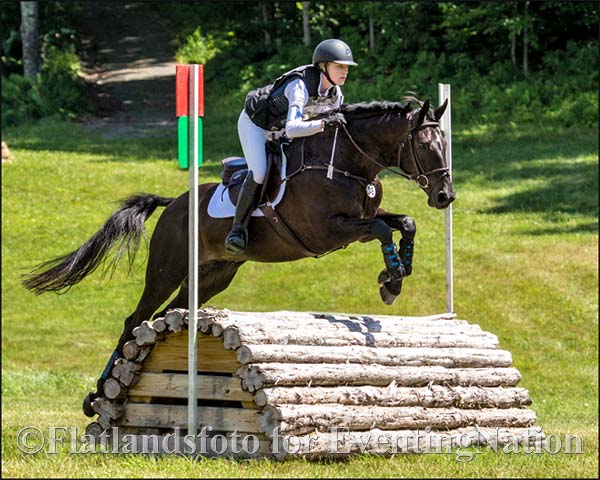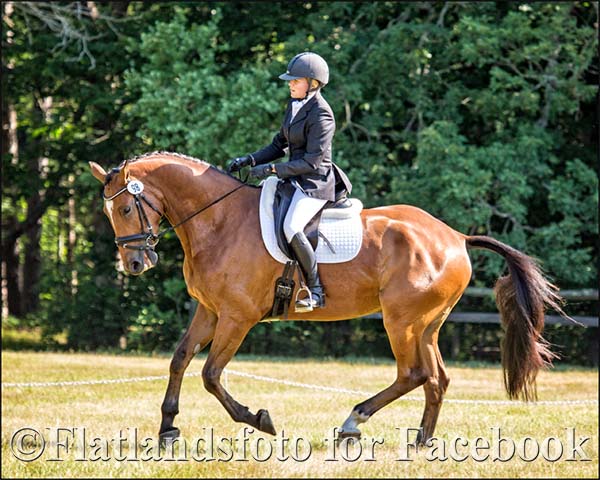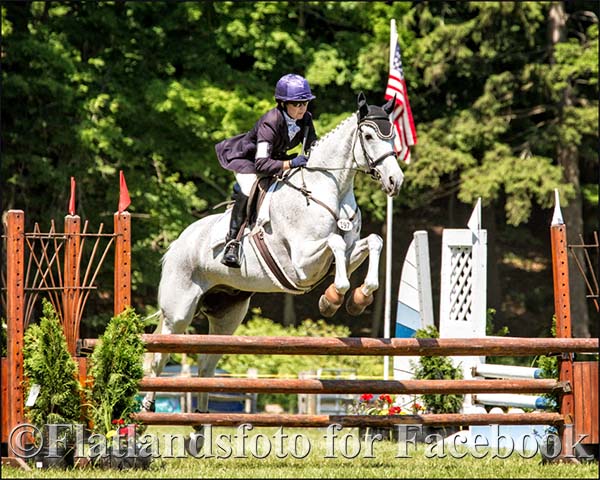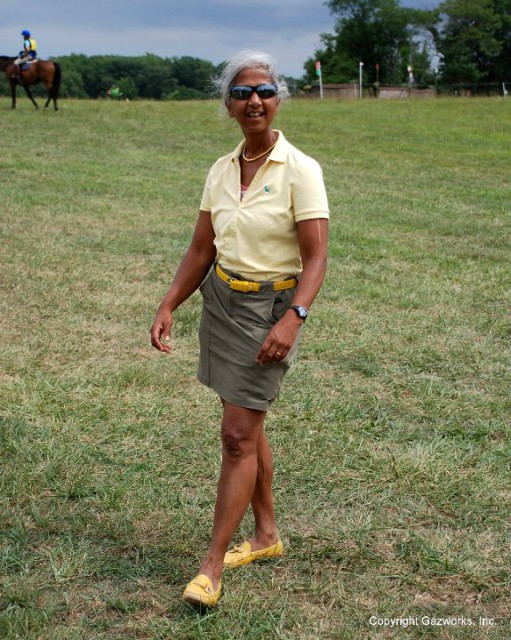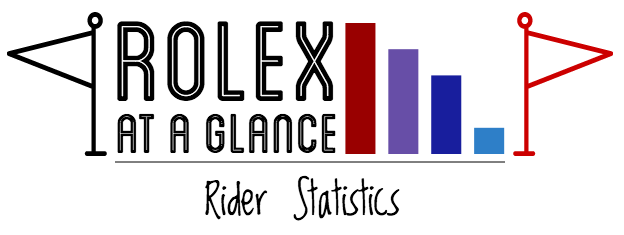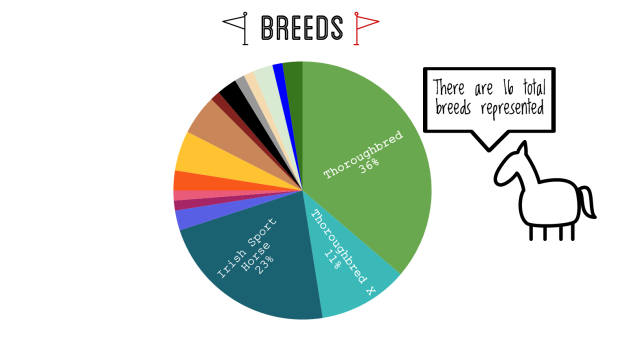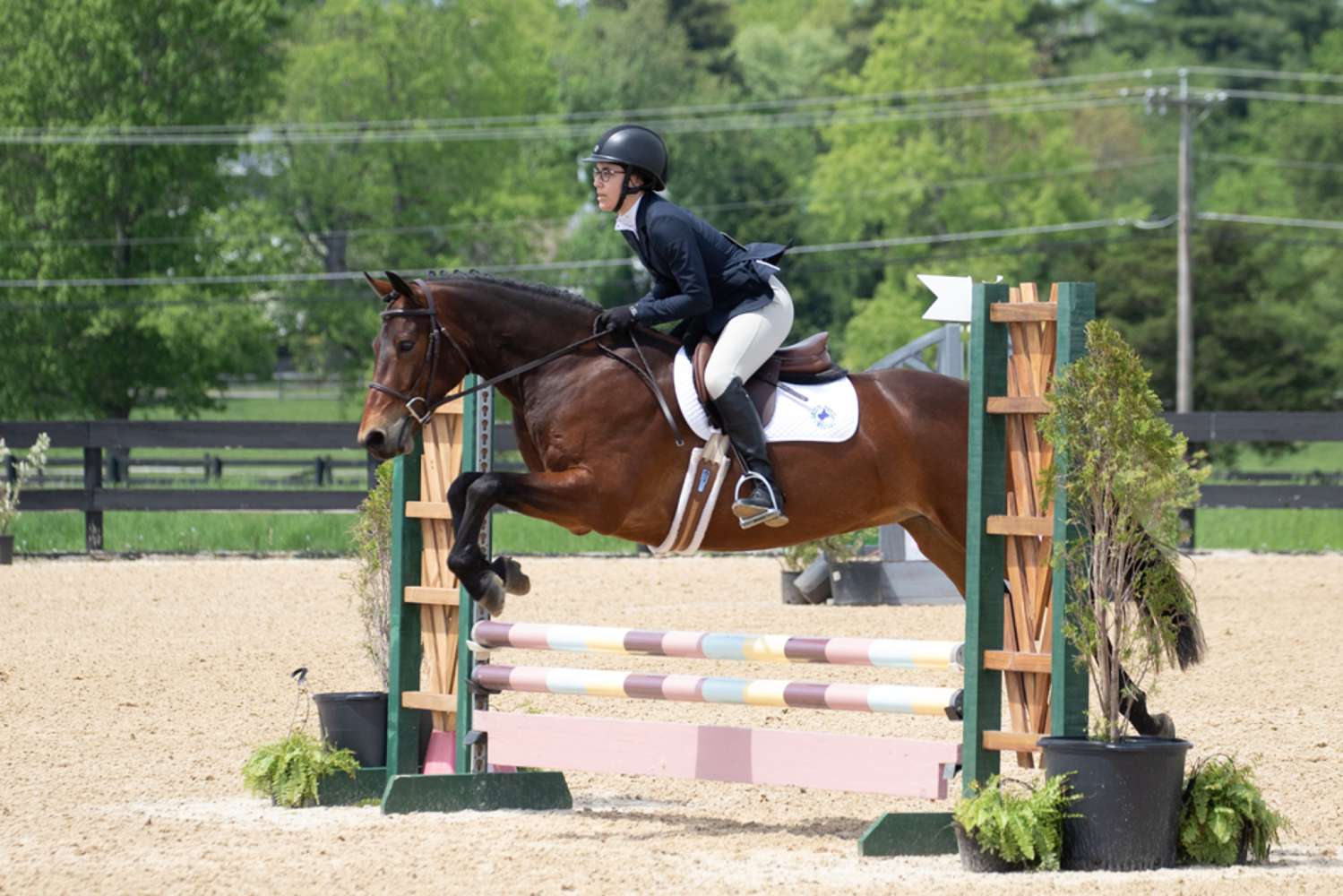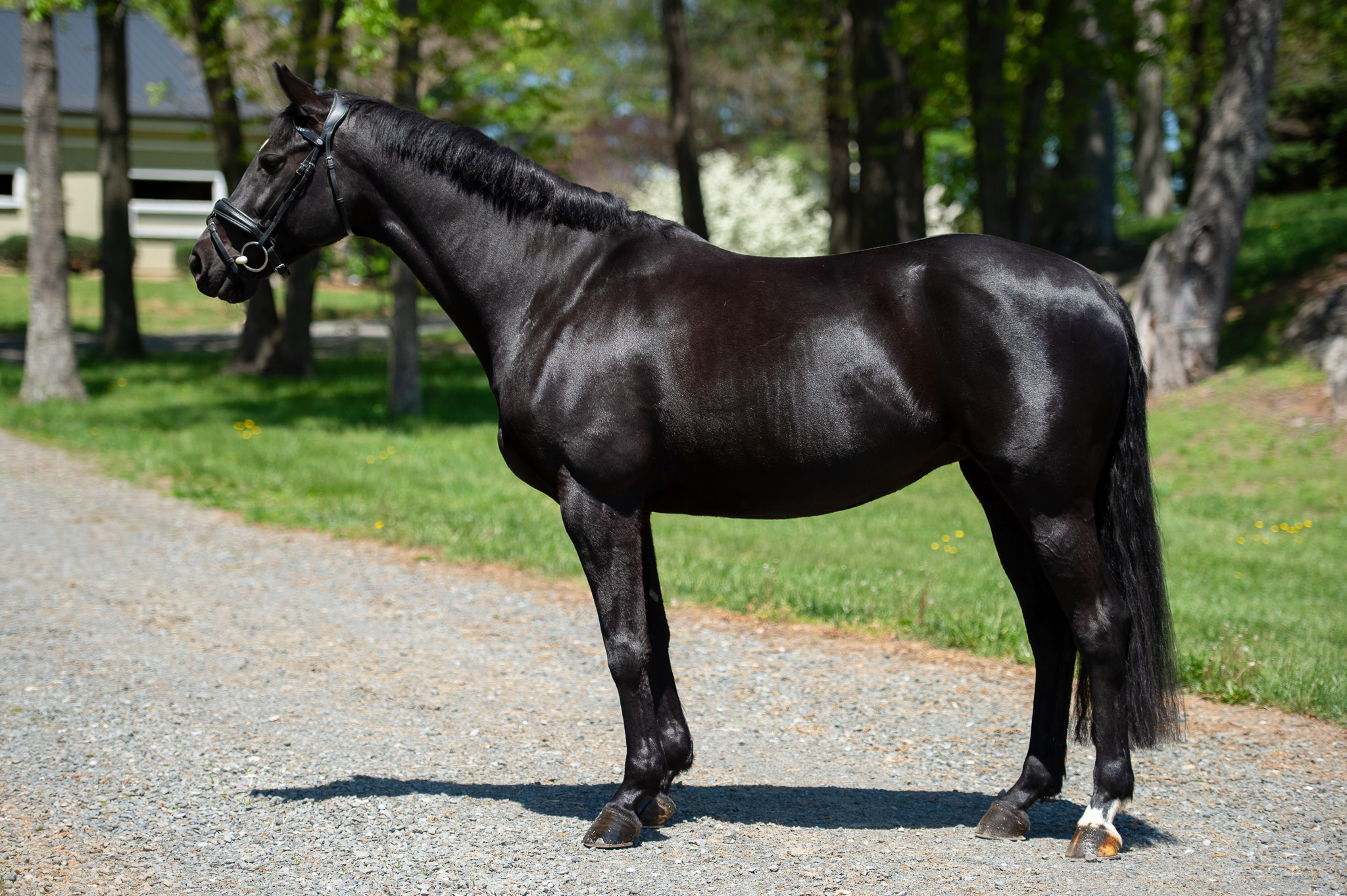Laine Ashker and Anthony Patch have been a mainstay at the Advanced level in the U.S. since 2008, completing major events like Rolex Kentucky and Burghley much to the delight of their massive fan base. Her 2016 season unfortunately came to an early end when she suffered a broken humerus, torn deltoid bicep and torn rotator cuff in a fall after a client’s horse stumbled, but she’s on the mend and in good spirits.
We caught up with Laine to learn what she’s been up to during her recovery (including a very exciting business venture!) and her plans for next year, as well as an update on her mother Valerie’s cross-country trek on horseback, thoughts on social media and even some trot-up fashion advice.
EN: How are you feeling and how is the healing going?
Laine: “I’m doing lovely. I just got my third post-surgery checkup and I’m out of the sling. I’ve broken a lot of bones in this sport, but until now I had never realized exactly how big the humerus is! I have two metal plates and 20 screws keeping it together in there.
“This is actually the first week my shoulder hasn’t felt like it’s just jiggling around as I’m walking. I can’t even do much exercising which is a huge bummer, so the MyFitnessPal app has been my best friend. I’ve been using it to try and stay on some sort of a diet so that I don’t go overboard while I can’t be as active.
“I’m planning on being back in the tack and in work in December if all goes well. The next checkup with my orthopedist is early next month, so gotta keep the bone growing until then. I’ll either get the ‘all clear’ at that point or not, which would be a bummer, but I’m so fortunate to have an amazing team of girls — and one boy — working for me who are doing an amazing job taking care of the farm, so if I need to take another two weeks off I can.
“Of course I’m really eager to get back in the saddle, but I have to be smart about it because this is the type of injury where, if I get back on a horse too early and fall off before the bone is fully healed, it would be majorly damaging and would jeopardize my whole riding career. So compared to that, what’s another two weeks?”
EN: What have you been doing to keep busy during your down time?
Laine: “It’s been sort of a little bit boring, but luckily I’ve started Snapchatting and that’s been a life-changing app for me, because of course it has selfies and filters. But really I’ve just kept busy with being around the barn in a bit of a different management role than I’m used to. I’ve been spending a lot of time with my students coming up with fun things to do to help them learn, but also to get a little competition going. We set up a gambler’s choice jumping exercise the other day.
“I’ve also got a pretty exciting business venture called ‘iQuestrian’ that’s taking shape that I put feelers out for earlier this year. I’ve been able to utilize a lot of this downtime to work on that. I definitely won’t call this injury a blessing in disguise, but at least I have been able to focus on this project a little more than I otherwise would have. I’ve been learning to work smarter, not harder.
“iQuestrian is an app/website that I’m developing and essentially it’s a way for people in parts of the country without a lot of four-star riders to get in touch with me and other instructors and get some training that way. My #GOTDs (Grid of the Day) and #DEOTDs (Dressage Exercise of the Day) on Instagram have been so popular that I’ve wanted to expand on that idea and go bigger.
“It will have a library of instructional videos all the way from Starter level through Advanced with everything from gridwork and lateral exercises to creating the perfect quartermark and picking a jog outfit. There’s going to be a lot going on and I’m really excited about it. There will be a range of free and premium services, including the ability to shoot a video of yourself, send it in, and get a lesson from me or another top instructor that I’m hoping to bring in.
“The biggest thing I see when I travel around the country doing clinics is that people want to be part of a big trainer’s program, but they don’t live in the right area and they can’t travel or they don’t have the money. iQuestrian would make quality instruction more accessible to everyone, and I want it to be a source for people. Right now we’re still in the fundraising stage with sponsors, but I’m hoping to be able to roll it out next year.”
EN: How do you manage to stay so active on it while riding, competing and running a business?
Laine: “It’s so easy! I had the luxury of going to college and being introduced to Facebook there and using it to check in with friends, so I got the social media vibe from college life. Once you understand how easy it is to do, it just becomes part of your day-to-day.
“For the grids and dressage exercises, it takes me about 15 minutes to do those because I’ll trim the video, add audio and write out a caption, but I’m willing to take that time out of my day because it’s important to me and it’s important to my followers.
“I really enjoy commenting back to people. I put myself in their shoes and I think that if they took the time to write to me then I should do the same for them. I really do enjoy engaging with people, and I think it’ll be a very sad day when people stop commenting because that means then that they’ve stopped caring.”
EN: How is social media important to a professional equestrian? Any tips for other riders?
Laine: “Social media is hugely underutilized by riders. We riders are a business, but the world of equestrian sports is still so backwards in its elitist mindset, thinking that we’re just entitled to ride. In reality we need sponsors and companies to allow us to ride full-time, and we have to do our part to represent those companies and get their name out there. Social media is a powerful way to do that, but it’s taken a lot of time to catch on and is slowly gaining momentum.
“I have spent a lot of time analyzing what kind of posts get good reach and which don’t; I think I have business school to thank for that. I’ve found that people like motivational posts such as #motivationmonday, but they don’t like selfies. I like to use Twitter for checking results because it’s so quick and instant; it’s so easy, anyone can do it. And Instagram is amazing because you can link it to all your other social media accounts. One click and the post goes up on Facebook, Twitter, Tumblr, Swarm — you name it! It literally takes me a minute to do.
“I get that there are some people that don’t want their life to be public, and that’s OK, but the great thing about it is that you can let people in as much or as little as you want to and you can pick or choose what helps you build your brand.
“I think it’s really easy to lose our perspective of reality in this sport. I like to go out and talk to people and and talk about things other than horses and riding, and have different experiences outside of horses. I find it to be a bit therapeutic for me, putting myself out there and working through some of my problems publicly. It helps with knowing you’re not alone. I think that’s what helps people like myself be a little more relatable. It show that you don’t have to be a superstar who wins everything to be a role model.”
EN: A lot of young riders look up to you as a role model on social media. What advice do you give your followers about becoming a better rider?
Laine: “I do pride myself on being a role model and, I always have to remind myself whenever I post that as I have a responsibility as such. Proper role models have to show people that they’re not without mistakes and that they’re flawed. If you only post your successes — your perfect halts and your 10s — then that’s not reality. It’s important to see that sometimes that person falls, but then that they got back up and they learned from it. That’s what I really want to show my followers.
“The biggest thing I tell my young riders is to persevere. I tell people that if they give up too soon — whether it’s getting off the horse and quitting for the day, or having a refusal at a jump and giving up on getting the horse over it — that you don’t have to fight and prolong it, but you have to find a different way to get it done and maybe speak a different language to the horse.
“The same goes for if you’re short on money. There are still means to following your dreams and achieving them. I am walking, living proof that these things can happen: that you can go to college and take a full load of classes and still do four-stars, that you can take horses off the track and be successful with them. You don’t need to have someone go to Europe and import a horse for you. I mean, would I love that? Heck yeah! But it’s not realistic for everyone, so I take OTTBs and retrain them instead.
“‘Keep your eye on the prize’ is one of my biggest mottos. It’s a saying that’s really resonated with me and helped get me where I am today, and I haven’t even gotten to do an eighth of what I’ve wanted to do yet. It’s something that I tell my students. I’ve texted it to my mom along her journey, and I’ve had to say it to myself again just a couple weeks ago after my accident. You have to persevere when something’s not going right and find a different means to that end. We all have those peaks and valleys; we just have to persevere through them.”
EN: Right now your mom is persevering through her ride across the country, and she’s almost done! As a daughter, what has it been like for you watching her go on this journey?
Laine: “There’s such a mix of feelings. There was a point before I got hurt where she didn’t have a driver for the trailer, and it was tough and I practically wanted to stop my show season early to be there for her. Of course now my show season ended early anyway! I never had one iota of doubt that she’d finish this journey, though.
“I can’t even describe the amount of pride I have for her. My success has been because my mom never babied me and never put me on any made horses. She made me understand how to create a diamond out of someone else’s trash. This has been something she has wanted to do for a long time. She’s already crossed the country several times with me in the car and also on her own on her motorcycle, so it was only a matter of time until she did it on horseback.
“I can’t tell you the amount of relief I’ll have too when she’s done, but also just such a sense of pride and gratitude towards those horses for letting her do this. Those two horses, Primitivo and Solar Express, never swapped out. Those horses have walked every step of the way from California to Virginia. They never got driven on the trailer. In fact, I think they’ve probably gone an extra 20 miles just from getting loose!
“She has met so many amazing people along the way that have touched her life. It’s really come full circle because the OTTBs have given me so much: my first Rolex press conference and my first Burghley, just to name a few. Now they’re giving back to my mom to fill a void in her life and she’s giving back to them. She’s showing people what incredible creatures they are.
“I think they get a bad rap because people always talk about ‘crazy Thoroughbreds,’ but every horse given the right chance can be someone’s Sylvester or Black Beauty — their dream horse. It’s just a matter of how their second life is presented to them; that doesn’t include forcing it on them, but it doesn’t mean letting them walk all over you either. There’s a happy medium.
“Working with these horses is her calling, and she’s found it. She has really found her niche in this off-the-track Thoroughbred movement. She’s so talented at not only finding them, but starting them and showing them a whole new avenue and gaining their trust. Her face just lights up when she talks about them.
“I hope that as many people as possible can come the the welcome party that we’re throwing her when she arrives and finishes her journey on Nov. 19 at the Middleburg Training Center in Virginia. I want it to be a huge part,y and I also want people to come see how amazing these horses look, because they look absolutely incredible!”
EN: Now that 2016 is coming to a close and you’re mending up, what does the next year look like for you and your own Thoroughbreds?
Laine: “Anthony Patch (Al) was supposed to be coming back into work by now, but that hasn’t happened since I got injured. All my other event horses have been on vacation too; we pulled their shoes and turned them out! So we’ll all be coming back into work together once I can ride again. We’ll be heading down to Florida in January, and I’d like to do our first show back hopefully at the end of that month. Pending the weather, I’d like to be back to jumping before we head south, focusing on my position and the horses’ form and getting my eye and distances tuned up.
“Al owes me nothing, so we’ll see what he wants to do. If I could get one or two more competitive years out of him I’d be thrilled, but if he tells me tomorrow that he wants to be retired then that’s fine. He’s a dude. I love him and he keeps me motivated every day. I’ve got a bone to pick with Rolex though, and I’d love to springboard off our amazing result from last year.
“As for going overseas, it’s a big risk, but if he’s sound we’d do it. It’s a matter of what he wants to do. It really depends on how he comes out of Rolex because that tells me a lot about how he’ll keep recovering over the summer. We ran cross country towards the end last year, and that wasn’t great because the footing got so dug up and tough; it took him longer to recoup after.
“Skipping Burghley last year was a good decision because of that, but I would love to go again if we can. The first time around I was convincing myself that we would do it as we went. Now I know we can. God bless Al for putting up with me and making the thousands of mistakes that I did. Now I’m finally able to live up to him.
“Spartan (Flagmount’s Spartan) and Comet (Calling All Comets) are my two-star horses. Both of their seasons got cut short unfortunately because of my injury. Comet is an all-American, homebred thoroughbred and he’s very special. He did his first two-star at Carolina earlier this year and finished on his dressage score. He’s going to be the horse of the future, and I’m very excited about him.
“Spartan, who’s owned by Tera Call and myself, is a year older than Comet and he’s three-quarters thoroughbred, one-quarter Irish. He’s a dude. I got him from Grand Prix jumper Aaron Vale who just had him in a pasture and hadn’t shown him. He’s only been competing for three years now and is already at the two-star level. He’s a Burghley horse through and through. He’s very cheeky.
“Both Comet and Spartan are going to stay at the two-star level this year and won’t move up. They’re both further along with their jumping and need to catch up with their flatwork, and I think the two-star level is the time to do that; it’s a hard enough jumping level to keep them interested, but there are enough flatwork basics that need to be worked on.
“I was talking to Boyd Martin at a recent show and he was telling me about a study that showed that horses that stayed at the two-star level for a longer period of time went on to have longer careers than those that moved up to three-star sooner. Both Comet and Spartan are still young, so there’s no rush.
“Patrick (Call Him Paddy) is an OTTB that my mom found through the Retired Racehorse Project. He’s 15.3 hands of cockiness, heart, guts and talent. He really reminds me of my Al; he’s an incredible horse. He walks around the barn like he just won a six-star — we have to make up levels for him, he’s that cocky! He just has an ‘I’ve got this’ attitude. He’s going Prelim right now and hopefully we’ll do a one-star in the spring. Maybe we’ll do a two-star later in the year, but he’ll just be turning 7 next year, so we’re not in any hurry.”
EN: In addition to eventing, you’ve also been competing in pure dressage. What do enjoy about it?
Laine: “I have two pure dressage horses, both owned by good friend Ann Wilson. I’m so lucky to have an owner like her. Diego (Santiago del Escarvido) is an Andalusian/Appaloosa and we’ll be doing Intermediare I and II next year and maybe even Grand Prix in the fall, and Tommy (Phantom In The Knight) is an Andalusian/Arabian and we’re at Second Level.
“Competing in pure dressage is so awesome and humbling. Dressage never ceases to humble me and make me feel like a little kid again. Earlier this year I just learned to do a couple steps of piaffe and I just had the biggest grin on my face; I felt like a little kid who had just learned to canter.
“I would love to develop a string of dressage horses as well. I’m learning a ton, and it helps me so much in my eventing dressage. I’ve been working with dressage trainer Radu Marcoci who has ridden at the Spanish Riding School and at the Seoul Olympics, and he’s been riding and lunging Diego and Tommy while I’m healing which has been super.
“I’ve been learning so much being in the dressage world. It’s like I’m a Beginner Novice rider watching Phillip Dutton out on cross country. Everything I’m learning I get to share it all with my students, so it’s like the gift that keeps on giving.”
EN: You’re quite the fashionista on the jog strip. What do you look for in the perfect trot-up outfit?
Laine: “I have a formula for trot-ups with big publicity. For Wednesday jogs, I like to go with some sort of dress. I want it knee length or below, but not too long because you don’t want to be tripping over yourself.
“On Sunday for the second jog, I like some sort of pantsuit. You want to stay away from dresses on Sunday in case you need to ride your horse that morning before the jog to loosen them up; you don’t want to have to do a full wardrobe change. On Wednesday, you can pay more attention to yourself because you have more time to get ready and you’re not dealing with a sore horse that day, so that’s the day to go all out.
“Otherwise, you just have to go with your own style. For me, I love to go with a classic look, but then give it a little edge. I don’t want to be boring. I like to go light with eye makeup, but add a pop of lip color. You want to steer away from going too heavy on the eye makeup and end up looking like you’re going to the club. If you need a statement, do lip color. I like to keep it seasonal too — a light pink for spring, and a deeper plum for fall.
“I know a lot of people don’t care, but the trot-ups are the one time in our sport where we can really express our personalities. Yeah, we can bring a little bling into dressage, but we still have to keep it really understated and uniform. The jogs are the part where we get to be different, and I love seeing how different people choose to look and how confident it makes them.
“I for one loved Chris Talley’s outfit at Fair Hill; he looked like a total Ken doll. He pulled off those leather pants better than most women could have and his hair was also on fleek. That’s a big thing for me too. Don’t just pay attention to your outfit; pay attention to your hair also. Don’t just let it go and look disheveled. There’s really something to be said for just a simple slicked-back ponytail, which is so easy to do. I loved my bun at Rolex, but I have shorter hair now, so I’m going to have to figure out what I’m going to do next.
“And don’t forget to take your horse’s coat color into account. I loved what Tiana Coudray and Becky Holder have done in the past with their grays. I’m excited to get Spartan, who is gray, up to that level and do some really bright fun colors. No offense to my Al here, but he’s a pretty boring color!”
EN: What do you like most about MOJO?
Laine: “I have a MOJO bracelet on right now! I have one that just looks like a normal silver bracelet and it never leaves my wrist. I really love how it helps with balance. I think it really helps me find my center of gravity and helps keep me in the center of my horse. I for sure feel like it’s helping with my shoulder right now too and it’s going to be even more important to me know since there is a significant amount more of weight in my right shoulder now since I have all that hardware in there.
“I think my balance is going to be skewed from that hardware, and I think the MOJO is really going to be helpful for helping me regain my balance again. They don’t just do products for people either. They have the power packs for horses that go on the bridle and dogs for their collars. I think they’re really helpful for getting the horses to acclimate and focus.”
Use promo code GOMOJO for $10 off any MOJO bracelet! Shop at MOJOFutureTech.com







